For most DIY projects, a 10-inch miter saw should suffice. However, if you plan on working with larger pieces of wood, a 12-inch miter saw may be more suitable.
When choosing a miter saw, it’s important to consider your specific needs and the type of projects you’ll be working on. Additionally, the saw should have a good motor and blade quality to ensure accuracy and precision in your cuts.
Investing in a high-quality miter saw will not only make your project easier, but it can save you time and energy in the long run. With the right size and features, a miter saw can be a valuable addition to any DIYer’s toolkit.
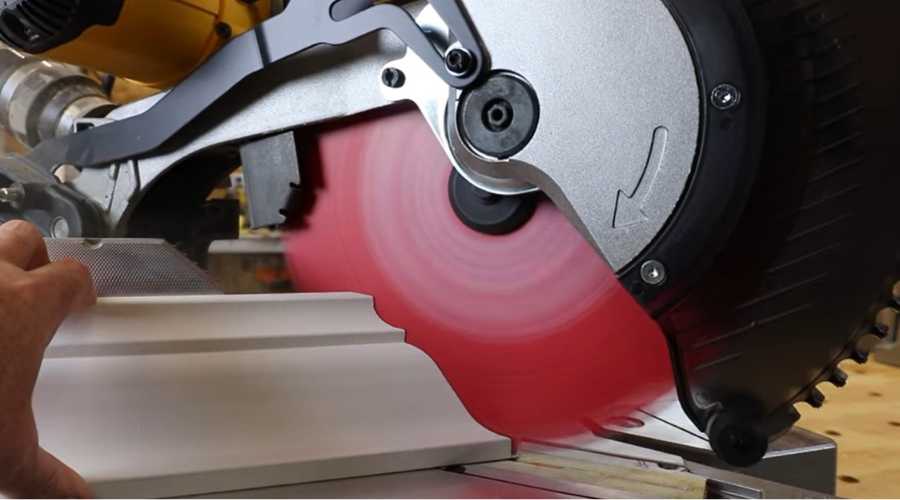
Understanding Miter Saw Sizes
Miter saws are versatile power tools that can make precise and accurate cuts for woodworking, metalworking, and other DIY projects. Different miter saw sizes are available, each with its own advantages and disadvantages.
Let’s break down what you need to know about miter saw sizes.
Explanation Of The Different Miter Saw Sizes Available
When it comes to miter saw sizes, the blade diameter is the most important factor. The most common sizes available are 7-1/4 inches, 10 inches, and 12 inches.
7-1/4-inch miter saws: These saws are lightweight, compact, and portable, making them an excellent choice for small projects. They can handle most trim work and narrow boards, but not thick lumber or large sheets of wood.
10-inch miter saws: These saws are the most versatile and widely used. They can handle larger boards and thicker materials, making them suitable for a wide range of projects, including crown molding and furniture making.
12-inch miter saws: These saws are the most powerful and largest of the three, with the ability to cut thicker materials with ease. They are ideal for professional carpenters and contractors who work with large lumber and framing materials.
Advantages And Disadvantages Of Each Size
Each miter saw size has its own set of advantages and disadvantages, depending on the project you are working on. Here’s a quick overview:
| Miter Saw Blade Size | Advantages | Disadvantages |
|---|---|---|
| 7-1/4-inch miter saws | • 7-1/4-inch or 8 inch miter saws are lightweight, compact, and portable. • It is ideal for small DIY projects or light-duty work. • They can handle materials with a thickness of up to 1.5 inches. | • Limited in cutting capacity and power |
| 10-inch miter saws | • 10-inch miter saws are the most common type of miter saw available. • They are versatile, widely used, and suitable for most projects. • It can handle materials with a thickness of up to 2 inches. | • May struggle with thicker materials |
| 12-inch miter saws | • A 12-inch miter saw is the most powerful and largest type of miter saw you can buy. • It is ideal for heavy-duty projects or larger pieces of wood. • A 12-inch miter saw can handle material with a thickness of up to 3.5 inches. • Sliding compound miter saws usually have 12-inch blades. | • Heavy, large, and costly |
Determining Which Size Is Best-Suited For Specific Projects
Choosing the right miter saw size depends on the type of project you are working on. Here are some tips to help you decide:
Small projects, such as cutting trim and molding: A 8-inch miter saw is a good choice for small projects. It is lightweight and portable, and it has a cutting capacity that is sufficient for most trim and molding.
Medium-sized projects, such as cutting framing lumber and plywood: A 10-inch miter saw is a good choice for medium-sized projects. It has more power and a larger cutting capacity than a 8-inch saw, making it ideal for cutting thicker lumber and plywood.
Large projects, such as cutting hardwood and crown molding: A 12-inch sliding miter saw is a good choice for large projects. It has the power and cutting capacity to handle even the most demanding tasks.
Here are some specific projects that are well-suited for each size miter saw:
| 8-inch miter saw | 10-inch miter saw | 12-inch miter saw |
|---|---|---|
| • Cutting trim and molding • Cutting small lumber for DIY projects • Making simple miter cuts | • Cutting larger lumber for woodworking projects • Building furniture • Making compound cuts • Cutting hardwoods | • Cutting large pieces of lumber for construction projects • Building decks and fences • Making precise cuts for fine woodworking |
Remember, the most important factor to consider when choosing a miter saw size is the blade diameter, which determines the cutting capacity and power of the saw. Whatever size you choose, make sure it suits your specific project needs.
Understanding miter saw sizes is essential in choosing the right tool for your next project. By considering the different sizes available, their advantages and disadvantages, and which is best-suited for specific projects, you can make an informed decision and achieve precise and accurate cuts.
What Size Miter Saw Do I Need For Woodworking?
The best size miter saw for woodworking depends on the types of projects you plan to do. The most common miter saw blade sizes are 8, 10, and 12 inches.
8-inch miter saws: These saws are lightweight and portable, making them a good choice for hobbyists and DIYers. They can handle most basic woodworking projects, such as cutting trim, molding, and small lumber.
10-inch miter saws: These saws are more powerful and have a larger cutting capacity than 8-inch saws. They are a good choice for woodworkers who do a variety of projects, including cutting larger lumber and making compound cuts.
12-inch miter saws: These saws are the most powerful and have the largest cutting capacity. They are a good choice for professional woodworkers and contractors who need to cut large pieces of lumber and make precise cuts.
If you are unsure which size miter saw to get, it is a good idea to start with a 10-inch saw. This will give you the flexibility to handle a wide range of projects without breaking the bank. If you find that you need a more powerful saw with a larger cutting capacity, you can always upgrade later.
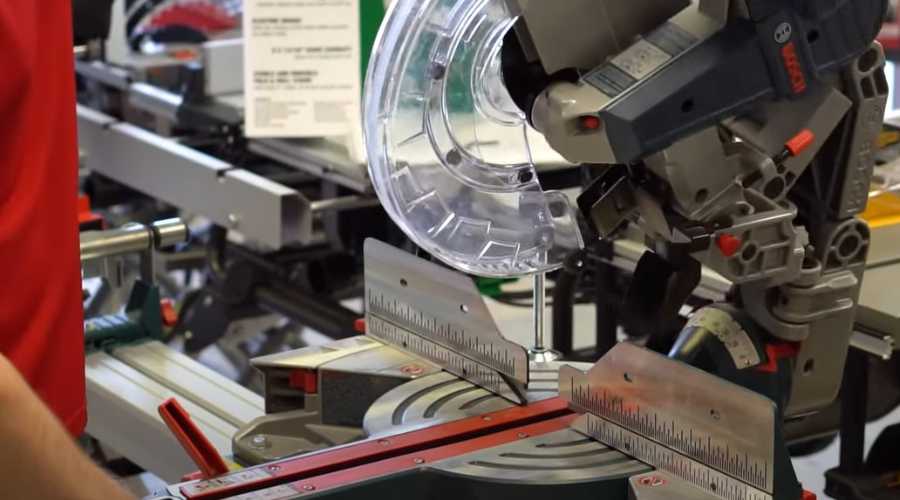
Here are some additional things to consider when choosing a miter saw:
Sliding vs. non-sliding: Sliding miter saws have a blade that slides forward and backward, allowing you to make wider crosscuts than with a non-sliding saw. If you plan on cutting wide boards or nested crown molding, a sliding miter saw is a must-have.
Power: Miter saws are typically powered by motors ranging from 10 to 15 amps. Higher-amp motors provide more power, which is important for cutting hardwoods and thick lumber.
Features: Some miter saws come with additional features, such as laser guides, shadow guides, and digital angle displays. These features can be helpful for making precise cuts quickly and easily.
I recommend reading reviews and comparing different miter saws before making a purchase. This will help you find the right saw for your needs and budget.
Factors To Consider When Selecting the Right Size Miter Saw
When selecting the right miter saw, there are several factors you should consider.
Type Of Project
The type of project you undertake determines the size and capacity of the miter saw needed. You will need a larger saw for larger woodworking projects that require cutting larger pieces of wood.
Material Size And Thickness
The size and thickness of the material you want to cut will also affect the type and size of miter saw you need. If you’re cutting thicker materials, you’ll need a saw with a larger blade, less tooth count, and a higher rpm.
Accuracy Required
If you a precise cut is necessary, such as cutting crown moldings, you’ll need a miter saw with a higher degree of accuracy. Look for saws with better blade adjustments, laser guides, or led lights for enhanced precision.
Frequency Of Use
Your frequency of use is important in determining the type of miter saw you should buy. For a frequently used saw, you will need a heavy-duty model that is built for continuous use without causing undue wear and tear.
Budget Constraints
Budget is usually a significant consideration, and it’s critical to find a miter saw that fits your budget without sacrificing features, quality, and performance. You can find miter saws that range in price, from budget-friendly models to high-end models. Determine which aspects of the saw are most beneficial and which features are not important to achieve a balance between budget and performance.
Remembering these factors while selecting the miter saw will help you make an informed decision while purchasing the right miter saw that suits your needs.
Blade Size Vs Miter Saw Size
Correlation Between Blade Size And Miter Saw Size
When selecting a miter saw for your DIY woodwork project, you will come across different blade sizes, including 7-1/4-inch, 10-inch, and 12-inch blade sizes. However, you must ensure that the blade size correlates with the miter saw size, as the blade size determines the cutting capacity.
Here is what you need to know:
- A smaller blade size means a smaller miter saw size, while a larger blade size corresponds with a larger saw size.
- Although larger blade sizes have more cutting capacity, they are suitable for larger projects and can be overwhelming for small to medium-sized woodwork tasks.
- If your work involves cutting smaller frames or trimming thin moldings, a smaller 7-1/4-inch blade size may suffice. However, if you work with larger baseboards or crown moldings, a larger blade size may come in handy.
Effect Of Blade Size On Cutting Capacities And Accuracy
The cutting capacity of a miter saw depends on the blade size. When deciding on the right blade size for your project, consider the following:
- The blade size affects the cutting capacity, as larger blade sizes can cut deeper and wider than their smaller counterparts.
- Larger blades can accommodate wider boards and thicker materials, making them suitable for professional-grade cutting tasks.
- A larger blade translates to larger teeth, hence a more precise cut. However, smaller blade sizes can produce delicate cuts for moldings and other intricate projects.
- Using the right blade size for your project ensures that you achieve accuracy and precision in your cuts.
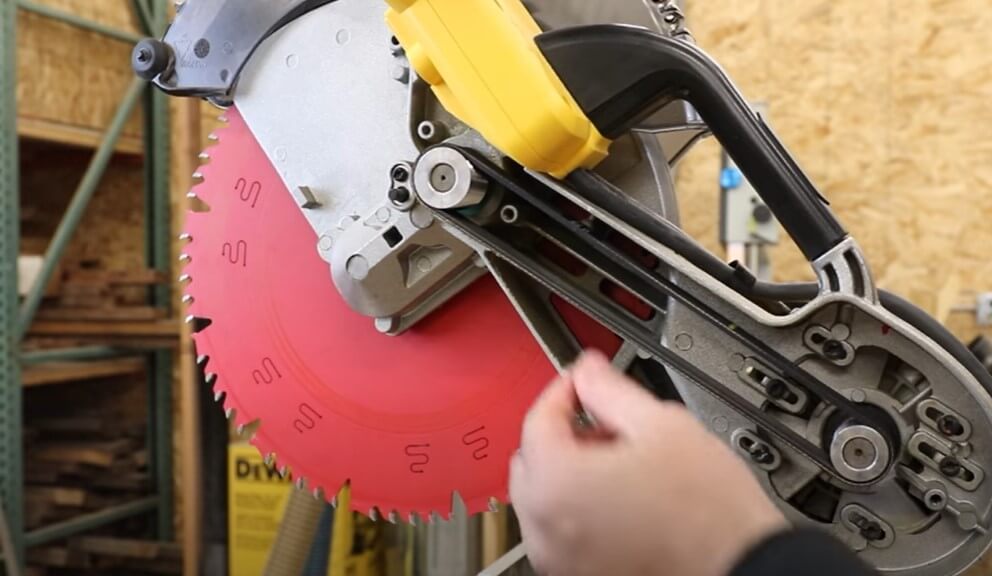
Choosing The Right Blade Size For The Project At Hand
Choosing the right blade size is crucial for achieving accurate and precise cuts in your DIY woodwork project.
Here are some factors to consider when selecting the appropriate blade size:
- Determine the thickness and width of the material you will be cutting.
- Identify the cutting capacity of each blade size and select the one that best suits your project.
- Ensure that the blade size correlates with the miter saw size to avoid overworking the machine or producing inaccurate cuts.
- Do not overlook the importance of blade tooth count, as this affects accuracy and precision.
Selecting the appropriate blade size for your miter saw depends on the project’s scope, thickness, and width of the material to be cut. Choosing the wrong blade size can lead to inaccurate cuts and damage your equipment. However, with the right blade size, you can achieve precise and accurate cuts in your DIY woodwork projects.
Features To Look For In A Miter Saw
When choosing a miter saw, there are a few important features you should look for to make sure you get the best tool for your needs. Here are some of the features you should consider when choosing a miter saw.
Laser Guide
A laser guide is a feature that projects a beam of light onto the workpiece, indicating exactly where the blade will cut. This can be especially helpful for beginners, as it can help ensure accurate cuts.
When choosing a miter saw, look for a laser guide that is easy to adjust and stays accurate over time.
- Laser guide ensures accurate cuts by projecting a beam of light onto the workpiece.
- Choose a miter saw with an easy-to-adjust laser guide that stays accurate over time.
Dust Collection System
Miter saws create a lot of sawdust, which can make a mess of your workspace and even pose a safety hazard. A dust collection system is a feature that helps to keep your workspace clean and free of debris.
When choosing a miter saw, look for one with a good dust collection system that is easy to use and maintain.
- A dust collection system helps keep your workspace clean and free of debris.
- Choose a miter saw with a good dust collection system that is easy to use and maintain.
Bevel Angle Range
A bevel angle is the angle at which the blade tilts to one side or the other. A miter saw with a wider bevel angle range can make more versatile cuts, allowing you to work with a wider range of materials and angles.
When choosing a miter saw, look for one with a wide bevel angle range that is easy to adjust and stays accurate over time.
- A wider bevel angle range allows you to make more versatile cuts.
- Look for a miter saw with a wide bevel angle range that is easy to adjust and stays accurate over time.
Positive Stops
Positive stops are preset points on the miter saw that allow you to quickly and easily set the blade to common angles, such as 45 or 90 degrees. This can save you time and frustration when making repetitive cuts.
When choosing a miter saw, look for one with good positive stops that are easy to use and accurate.
- Positive stops are preset points that allow you to quickly and easily set the blade to common angles.
- Choose a miter saw with good positive stops that are easy to use and accurate.
Different Types Of Miter Saws
When it comes to woodworking projects, a miter saw is an essential tool to have in your arsenal. With the ability to make angled cuts, miter saws come in a variety of types, each with its own unique features.
Understanding the differences between them can help you determine which one is best for your specific projects.
Here are the key points:
Compound Miter Saws
A compound miter saw can make angled cuts in both the horizontal and vertical planes simultaneously. It’s an excellent choice for cutting crown molding, picture frames, and other decorative pieces.
Here are a few things to keep in mind regarding compound miter saws:
- They can come with single- or dual-bevel capabilities (allowing you to tilt the saw blade to the left or right).
- They can make simple and compound cuts.
- They are typically less expensive than other types of saws.
Sliding Compound Miter Saws
As the name implies, sliding compound miter saws can slide forward and backward, allowing the saw to cut through thicker pieces of wood.
This type of saw is ideal for larger woodworking projects like cutting boards, furniture, and decking. Some things to consider when using a sliding compound miter saw include:
- They can come with single- or dual-bevel capabilities.
- They can make simple and compound cuts.
- They are more expensive than their non-sliding counterparts.
Dual Compound Sliding Miter Saws
Considered the most versatile of all the miter saws, dual compound sliding miter saws offer all of the features of a sliding compound miter saw with the added ability to make bevel cuts in both directions.
These saws are a great choice when cutting pieces that require complex angles, like stair treads and handrails.
Here are a few things to keep in mind regarding dual compound sliding miter saws:
- They have the ability to make all types of cuts.
- They are the most expensive type of miter saw.
- They usually come with higher quality features and materials.
Determining which type of miter saw is best-suited for specific projects takes some time and consideration. Consider the project requirements, your skill level, and your budget when making your choice.
What Size Miter Saw Do I Need To Cut A 6×6?
To cut a 6×6, you will need a miter saw with a blade that is at least 12 inches in diameter. A 12-inch blade will give you enough clearance to cut through the full thickness of the wood.
If you have a smaller miter saw, you can still cut a 6×6, but you will need to make multiple cuts. To do this, start by cutting the wood in half along its length. Then, make crosscuts to cut the wood to the desired width.
Here are some tips for cutting a 6×6 with a miter saw:
- Make sure the saw is properly calibrated. This will ensure that your cuts are accurate.
- Use a sharp blade. A dull blade will make it difficult to cut through the wood and could cause the saw to kickback.
- Secure the 6×6 to the saw table. This will help prevent the wood from moving while you’re cutting it.
- Use a push stick to feed the wood through the saw. This will help keep your hands safe.
- Make sure the saw is completely stopped before you remove the wood from the table.
Here are some additional safety tips for cutting 6x6s with a miter saw:
- Always wear safety glasses when using a miter saw.
- Make sure the wood is securely clamped in place before making a cut.
- Use a slow, steady feed rate when cutting.
- Be aware of the saw’s kickback potential. Kickback is a dangerous phenomenon that can occur when the saw blade binds in the wood and throws the saw back at the operator. To avoid kickback, keep your hands away from the saw blade and use a push stick to feed the wood into the saw.
If you are new to using a miter saw, it is a good idea to practice on scrap wood before cutting your 6x6s. This will help you get a feel for how the saw works and how to make safe cuts.
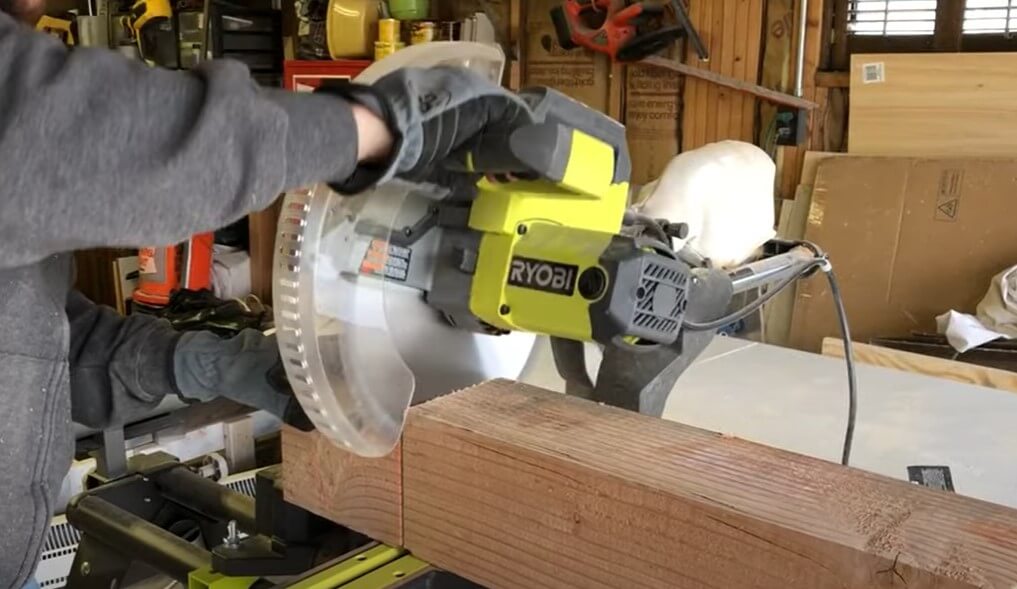
Will A 10-Inch Miter Saw Cut A 4×4?
Yes, a 10-inch miter saw will cut a 4×4. In fact, it is one of the most common uses for a 10-inch miter saw. A 10-inch blade has a cutting depth of about 3 1/2 inches, which is more than enough to cut through a 4×4, which is 3 1/2 inches thick.
However, if you are using a non-sliding miter saw, you may need to make two cuts to cut a 4×4 in half. This is because a non-sliding miter saw cannot make crosscuts on boards that are wider than the blade.
To cut a 4×4 in half with a non-sliding miter saw, follow these steps:
- Clamp the 4×4 to the miter saw table with the face you want to cut facing up.
- Set the miter saw to a 90-degree angle.
- Make a cut through the 4×4, stopping about 1/4 inch from the bottom.
- Flip the 4×4 over and clamp it to the miter saw table with the cut face facing down.
- Make a second cut through the 4×4, completing the cut.
If you are using a sliding miter saw, you can cut a 4×4 in half with a single cut. To do this, simply clamp the 4×4 to the miter saw table with the face you want to cut facing up and set the miter saw to a 90-degree angle. Then, slide the blade forward and make a cut through the 4×4.
No matter which type of miter saw you are using, it is important to always use safety glasses and other safety gear when cutting wood.
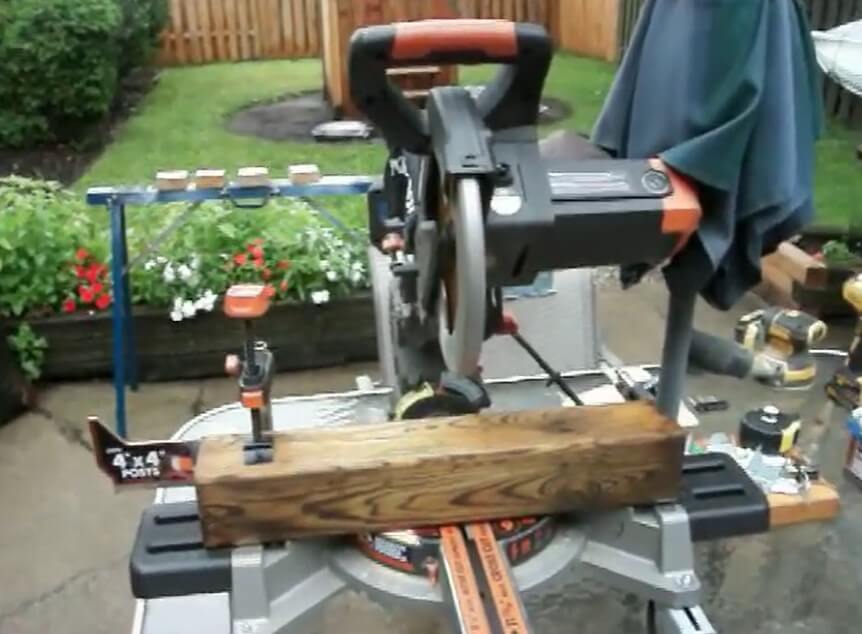
Different Popular Brands Of Miter Saw
Here are some of the different brands of miter saws available on the market:
Bosch: Bosch is one of the leading manufacturers of power tools, and their miter saws are no exception. Bosch miter saws are known for their accuracy, power, and durability.
DeWalt: DeWalt is another popular brand of power tools. DeWalt miter saws are known for their reliability, ease of use, and wide range of features.
Makita: Makita is a Japanese manufacturer of power tools that is known for its high-quality products. Makita miter saws are known for their precision, performance, and durability.
Metabo HPT: Metabo HPT is a German-Japanese manufacturer of power tools. Metabo HPT miter saws are known for their value for money and their wide range of features.
Ryobi: Ryobi is a manufacturer of affordable power tools that are popular among DIYers and hobbyists. Ryobi miter saws are known for their portability and ease of use.
Craftsman: Craftsman is a brand of power tools that is sold exclusively at Lowe’s. Craftsman miter saws are known for their durability and their wide range of features.
Other popular brands of miter saws include:
- Delta
- Evolution
- Festool
- Kobalt
- Ridgid
- Skil
These are just a few of the many different brands of miter saws available on the market. When choosing a miter saw, it is important to consider your needs and budget. If you are a professional woodworker, you will need a saw that is powerful and durable. If you are a DIYer or hobbyist, you may be able to get away with a less expensive saw.
It is also important to consider the size of the miter saw you need. If you plan on cutting large pieces of lumber, you will need a saw with a large blade and a sliding base. If you are only going to be cutting small pieces of wood, you can get away with a smaller saw.
Finally, be sure to read reviews of different miter saws before making a purchase. This will help you find the best saw for your needs and budget.
Frequently Asked Questions For What Size Miter Saw Do I Need
What Is The Ideal Size For A Miter Saw?
The ideal size for a miter saw depends on the type of project you’re working on. A 10-inch saw is perfect for smaller projects, while a 12-inch saw is better for larger ones.
Can I Use A 10-Inch Miter Saw For Large Cuts?
While a 10-inch miter saw can handle smaller cuts, it might struggle with larger cuts. It’s best to use a 12-inch saw for bigger projects.
Do I Need A Sliding Compound Miter Saw?
A sliding compound miter saw is ideal for cutting larger pieces of wood, but it also costs more. If your project requires angled or beveled cuts, you’ll need a sliding compound miter saw.
What Is The Difference Between A Single And Dual Bevel Miter Saw?
A single bevel miter saw can only tilt in one direction, while a dual bevel saw can tilt in both directions. Dual bevel saws are more versatile, but also more expensive.
Is A Laser Guide Necessary For A Miter Saw?
A laser guide isn’t necessary, but it can make your cuts more accurate. Some saws come with a laser guide, while others allow you to attach one yourself.
Can A Miter Saw Cut Metal Or Plastic?
A miter saw is designed to cut wood, but some models can also cut metal and plastic with the right blade. Check the manufacturer’s instructions to ensure compatibility.
How Do I Choose The Right Miter Saw For My Project?
Consider the size and materials of your project, as well as the types of cuts you’ll need to make. Research different saws and read reviews before making a purchase.
Conclusion
After exploring the different factors that come into play when choosing the right miter saw, it’s clear that there’s no one-size-fits-all answer to the question of what size miter saw do I need. It ultimately depends on your individual needs and preferences, taking into account factors such as the scope of your projects and the size of the materials you’ll be working with.
Whether you’re a beginner DIYer looking to tackle small projects or a professional woodworker taking on larger, more complex tasks, there’s a miter saw out there that’s perfect for you.
By considering the important factors outlined in this post and doing your own research, you can confidently select a miter saw that will help you create the perfect cuts for your project needs.
Recent Posts
Woodworking in 2025 is all about efficiency, precision, and smart technology. Whether you're a beginner or a seasoned craftsman, having the right tools can make all the difference. Here are the top 7...
Ever tried drilling into a piece of wood only to end up with a splintered mess or a wobbly hole? Yeah, it's more common than you think. Wood might seem like an easy material to work with, but...

